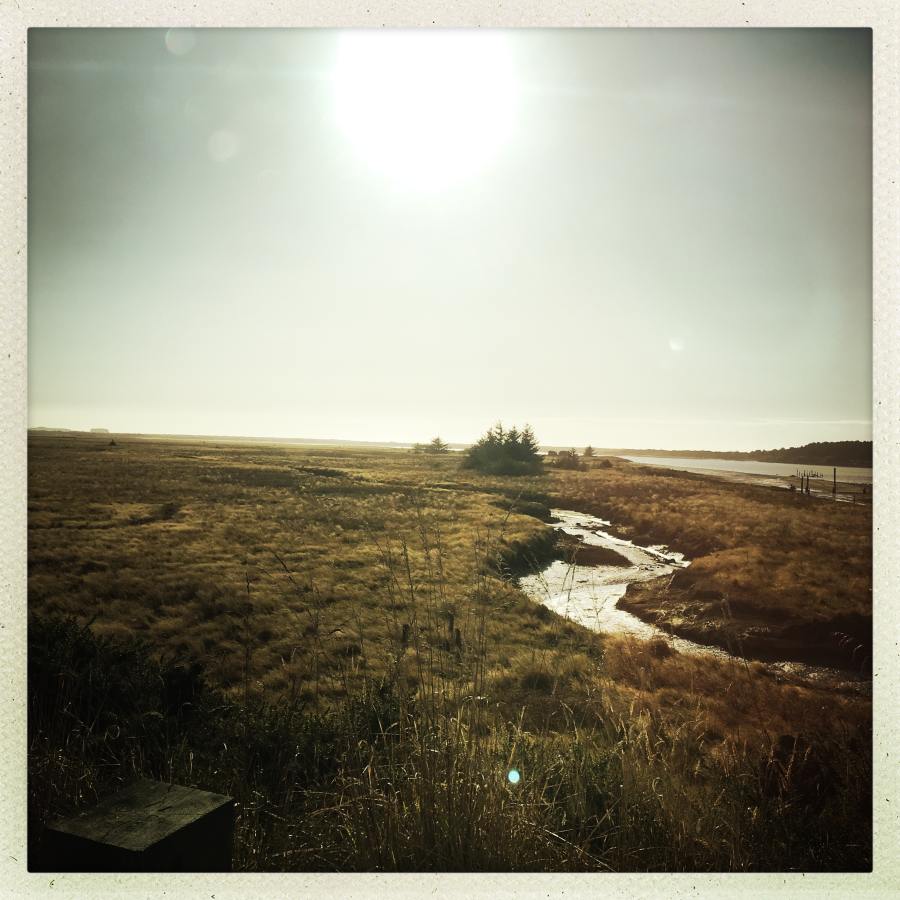It’s pretty out here.
Dragonfly forge is back about 7 miles inland from the coast at Bandon, where I’m staying. I did a little exploring; it’s nice and quiet “small town” America. It wasn’t until I’d been here for a few hours that I realized that this is a part of the pretty coastline that is going to be a disaster: you know, the Cascadia Subduction Zone that I’m scared of? [stderr] In geologic time-scales I am going to be in the dragon’s mouth for a fleeting instant, but I did have a good laugh at my own foolishness. I’m not sure if I feel foolish for coming here, or foolish for being afraid, or foolish for caring – it all seems small and random.

The wave would come from there
There are signs, which point the direction toward tsunami sheltered areas. I guess the idea is, if you feel the earthquake, you run – it says “11 minutes walk” – I bet I can make it in 5.

Hide in the high school
That infographic is a bit busy, for something that’s intended to be read in an emergency.

Oh, how educational!
That’s a zoom-in on the bottom left of the chart. I love the “YOU ARE HERE” arrow. It’s comforting.
When you drive inland past Bandon there are elevations covered with forest, and valleys with cows and some crops. The bottoms of the valleys are very flat and fertile. They must get scourged flat every so often – the slopes are craggy and I can’t see signs of a high-water mark. I’ll look more closely tomorrow if I live that long.

Bandon Marsh Wildlife Area
Dragonfly forge is up quite a hill (1/2 mile at a slope that my little rental hybrid didn’t like very much) it’s going to be fine when the tsunami comes; whoever’s there will have an amazing view. But, from the flatness of the valley, the waves must have made it at least that far.

I don’t understand rich people who choose to live in dangerous locations. Usually they have an option to move somewhere else. Unfortunately this is generally not the case for poor people.
Have you heard about people who are still living in Chernobyl’s toxic wasteland? http://www.telegraph.co.uk/news/earth/environment/9646437/The-women-living-in-Chernobyls-toxic-wasteland.html By now they are all elderly women. When the disaster happened people were forced to evacuate, but soon some returned to their homes. The surprising thing is that they are actually doing better than those who relocated. People who are displaced often suffer from anxiety, depression and disrupted social networks. These factors decrease life expectancy even more than living in a bad place.
On a smaller scale this also happens with people living in dangerous homes. In Latvia (same is true for Russia and a bunch of other places) there are a lot of old buildings. With time the walls start to crack and at some point building inspectors announce that it is dangerous to live in the house, because it can fall apart at any moment. At this point richer people usually leave, but the very poor people stay and continue living there. Then some government employees come and force people to move out. This usually results with them either living as homeless people on the street or illegally returning to continue living in the dangerous building. The latter option is generally the safer one, because life expectancy for homeless people may be actually worse than that of people living in bad homes.
This problem is even worse in Russia. In mid 70ties a bunch of toxic houses were built. In order to make the concrete cure faster builders mixed some toxic stuff into it. And now the very walls of these houses are constantly leaking phenol gas. There are people still living in these houses. They suffer from headaches and chronic illnesses and they tend to die, on average, at a significantly younger age than general population. Even house plants don’t grow and die in those houses. These people would love to leave and live somewhere else, but they cannot afford to buy another apartment. Besides, banks do not give mortgages for poor people anyway.
As for visiting places that may be destroyed by earthquakes, tsunamis, hurricanes, or whatever else, I’m fine with that. Disasters aren’t very likely to happen exactly when I’m there, so I consider these risks small enough to not worry. If I tried to avoid all possible risks, I couldn’t even get into a car. And such “safe” life would soon become very boring. And, judging from your photo, this looks like a beautiful beach.
leva: Speaking strictly from an American perspective, the argument we should only live in “safe” places would cram the entire U.S. population into what I have heard is the “:safest” place, Buffalo, NY
West Coast: Seismic disaster zone
Oklahoma and Texas, who woulda thunk that using explosives and chemicals to fracture the geology might cause a few earthquakes? Plus, look up “Tornado Alley”. And expected temperature levels and droughts in Texas and the high plains (where the corporate agriculture is draining the aquifers dry).
South East and Midwest: Tornados, drought, global warming, tropical diseases, toxic fundamentalist Christianity on the geological disaster level.
East Coast: Hurricanes, flooding
I don’t want to move to Buffalo. On the other hand, even from the perspective of an (inland) Northern Californian, I 2would never even consider living in coastal Washington or Oregon. Earthquakes are scary. Earthquakes plus a wall of water that wipes off the map everything in Seattle west of I-5 is scarier.